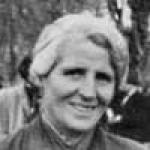LATA BRANDISOVÁ (26.6.1895 – 12.5.1981)

Countess Maria Immaculata Brandisová, the first and until now the only woman to have ridden the winner of the famous Velká Pardubická steeplechase, lived through the [Austro-Hungarian] Monarchy, the [first Czechoslovak] Republic, two world wars, and several regimes. Moments of fame and carefree existence were interspersed with periods of ruin and of being spurned, yet this delicately-built but psychologically immensely powerful woman never once complained about her fate.
Lata was born in Úmonín, near Kutná Hora, but the Brandis family later moved to Řitka1, south of Prague, where her mother had received an estate as her dowry. From childhood, the Countess2 came into contact with horses, and for her and her twin sister Kristina the very best times were those spent in stables or outside with horses. Her great uncle was Count Oktavián Kinský, one of the founders of the Velká Pardubická, and her father Count Leopold often took Lata and his seven3 other children to the races at Chuchle4. Although sportswomen did not by far have the same opportunities as sportsmen in those days, Lata Brandisová was able to launch her race-riding career5 at Pardubice in 1916, though she fell in her first race and did not get round.
After the great war, in which one of her brothers fell, Lata trained at Chuchle and achieved her first successes and wins. The post-war reforms6 considerably reduced the ancestral property, but the turning point for the young rider came in 1927, when her cousin and prominent representative of the Jockey Club in the First [Czechoslovak] Republic, Zdenko Radslav Kinský, invited her to Orlík, where he was preparing Kinsky horses to run at Pardubice.
From there, it was just a short stride to make a bold dream come true, and to announce Lata Brandisová, the first woman in the history of the race, as a rider in the Velká Pardubická steeplechase. After overcoming all the challenges and protests, Countess Lata Brandisová lined up at the start on the mare Nevěsta. In spite of falling five times, she finished fifth. She rode again in 1930 and 1931, on Norbert, with a better outcome, finishing 4th and 3rd. In 1933, Lata Brandisová rode the mare Norma in the race for the first time, and she again finished 3rd.
They got a final chance in 1937, after Norma had been ridden by an experienced foreign jockey but had finished 4th, victory again going to Germany. In a tense atmosphere, when everyone could sense the approaching military conflict, on October 17th Norma and Lata Brandisová lined up for the 56th running of the Velká Pardubická steeplechase.
"I came into the finishing straight on my beloved Norma, and forty thousand people went crazy with joy. I perceived how Norma was carrying me to victory, and I tasted happiness from the clapping and cheering of the crowd. It had never before been granted to me to experience such a marvelous feeling. The feeling that, far and wide, there was no-one who did not like me.” This is how Lata Brandisová described the most famous day in her racing career. The crowded amphitheatre was on the boil. Not just because a home participant had won again, but because the first woman in history had triumphed, the great favourite of the crowd, Lata Brandisová, in the saddle of the 10-y-o Chlumec-bred Kinsky mare Norma.
During the second world war, the family estate was put under German administration, but the five [unmarried] Brandis sisters were allowed to live in a small house in Řitka. However, for her horses Lata had to ride to Chuchle on her bicycle. After the war, just three of the sisters remained on the old estate, and Lata rode in the Velká Pardubická three more times, each time without finishing. Her last fall, in 1949, had more serious consequences8 than the several broken bones that she had suffered before, and the rider was knocked unconscious.
In the 1950s, the property in Řitka was confiscated from the Brandis sisters, and they had to move away from the chateau, which was made into a chicken shed, into a shack9 in the nearby village of Líšnice. They never went back into their old estate, or even visited the grave of their parents...
The Countess was already on an invalid pension, and in 1978 her twin sister Kristina died. A third sister, Jana, moved to Líšnice, and in 1980 Lata went to Austria with her nephew. There, half a year later, she died in May 1981. She is buried in the chapel of the barons of Reiterbegg alongside her sister Terezie and Terezie’s husband.
***
1 Řitka is just outside the southern boundary of Prague, near the Strakonice road (which passes Prague Velka Chuchle racecourse)
2 Even in socialist times, she was always known as the Countess
3 The Countess had two brothers, one of whom died in the first world war, and the other died between the wars, probably of tuberculosis. She had six sisters, including a twin sister.
4 Prague Velka Chuchle racecourse is less than 10 km north of the Brandis home
5 The Countess was related to leading Jockey Club personalities, who clearly gave considerable support to her riding and training career
6 Kinsky horses: http://en.wikipedia.org/wiki/Kinsky_horse
7 When the Austro-Hungarian empire collapsed and the Czechslovak Republic was established in 1920, the Austro-Hungarian aristocracy and other large landowners had much of their land confiscated. During the second world war, the Brandis sisters declared Czech citizenship, and the German occupiers put the Brandis estate under administration. Parts of her mother's family were accused of siding with the German occupiers. After the communists took over in Czechoslovakia in February 1948, the estates of the aristocracy were nationalized. Restitution began in the early 1990s, after the Countess had died. Aristocrats who had declared Czech citizenship and who had been resident in Czechoslovakia at the beginning of 1948, or who had a good lawyer, could exercise a right to reclaim their estates, which were, however, often in a tumbledown state. The estates of the Countess's father - where the Countess spent her last months - were in present-day Austria.
8 The Countess lived off an invalid pension. Her two sisters who lived with her, including her twin, went by train to work in the Orion chocolate factory in Modřany, in the suburbs of Prague.
9 The three sisters lived in straitened circumstances, without much heating and without running water (as did many other people at the time). It is said that the Countess never complained about her circumstances.
***
Written by Jiří Zlámaný, translated by Robin Healey
I was pleased to find this translation, which I think was published in 2011 on the Paddock Review website, shortly before that website became defunct. The Paddock Revue website was the precursor of the Dostihový svět website.
